Volleyball drills
- Ball is served.
- Pass by 1/5/6.
- Set-up by 1, but on a first pass by 1 set-up by 2.
- After set-up an attack by 2/3/4, but on a set-up by 2 only an attack by 3/4.
- After service 2 (or more) players walk into the court to play.
- Ball/ralley is played all the way out.
- NB: FOCUS IS ON THE SERVICE PASS!
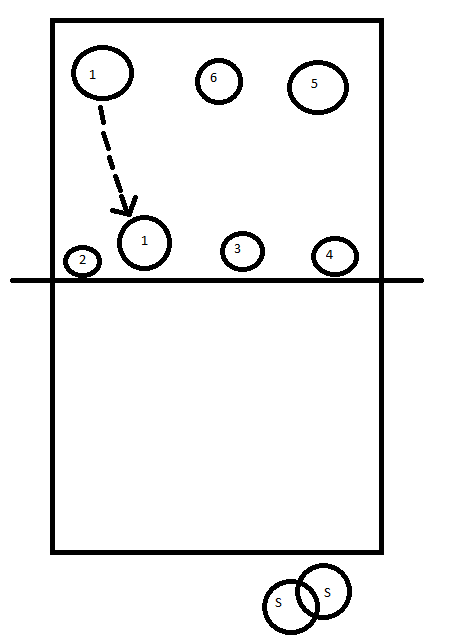
HIGH KNEE HUG FOR BALANCE --> PULL YOUR KNEE UP WITH YOUR ARMS TO YOUR CHEST AND RAISE YOUR OTHER LEG ON YOUR TOE
QUAD STRETCH --> FOOT TO BUTTOCKS WITH OPPOSITE ARM AND STRETCH OTHER ARM IN THE AIR AND OPPOSITE LEG ON TOE
SUMO squat --> through your KNEES like a sumo wrestler, elbow between your knees, between 2 steps with arm swing
Spider man --> walk forward on your hands and connect one leg by putting it next to your hand, walk forward on your hands and connect other leg, etc.
Front straight leg run --> run with stretched legs
ATLAS --> PULL YOUR KNEE UP WITH YOUR ARM AND EXTEND YOUR OTHER LEG ON YOUR TOE, STEP OUT WITH A BIG STEP AND BEND YOUR KNEE, SWING YOUR ARM UP AND TURN YOUR TORSO TO THE BACK
BABY SKIPS --> low SPRONG ON 1 BEEP AND LAND ON THAT BEEP, short swing in opposite direction (low variation of high skips)
This is always fun to do, especially the smaller kids like it.
- You have a monkey= This person is appointed by the trainer. This person must try to steal the coconut without getting caught.
- You have a coconut= This is basically just the volleyball, or another ball.
- You have a monkey hunter= This person is also assigned by the trainer, but the monkey hunter is ''undercover'', so he is just a palm tree but if the monkey has the ball in his hand, he may tap the monkey.
- And finally you have the Palm Trees= These are all the other players who are not the monkey or the monkey hunter.
You put all the players in a circle on one side of the field, in the middle of this circle you put the ''coconut''.
The trainer chooses the monkey in the presence of the whole team. The monkey then moves towards a wall or stands somewhere with its eyes and ears closed, facing the other way so it cannot see the team. You then say "The monkey hunter is....." (you point out the child, do not say the name of the child). If everyone knows who the monkey hunter is you say that the monkey can come back. The space between the palm trees where the monkey goes in the beginning, he must go back again.
For example, if the monkey goes between John and Peter in the direction of the coconut, it cannot go back between Hans and John.
If the monkey takes the coconut outside the circle without being tapped, the monkey wins.
If the monkey is tapped before it leaves the circle with the coconut, the monkey hunter has won.
- The blue balls are the "palm trees" players.
- The red dot is the ''monkey hunter''. The monkey does not know who the monkey hunter is. The monkey hunter is trying to tap the monkey.
- The white ball is the ''monkey''. He is trying to get the coconut without being tapped.
- The yellow ball is the coconut.
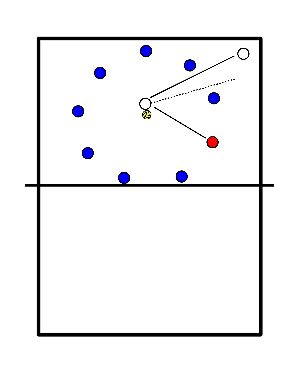
- Trainer stands at the net with a ball sticking out above the net
- Attacking run-up (short-long run) and watch arms swinging
- Make an offensive jump and try to touch the ball with the batting hand.
- Watch out:
- good posture
- good height
- arms well up
- Put down the close pass (brake pass) properly
- You can do this on both sides of the net, see picture. When you have completed the attack, pick up your ball and join the back of the line at the pawn.
- Red dots= Trainer
- Blue dots = players
- Orange dots= Pions
- Yellow dots= Volleyball
- Watch out:
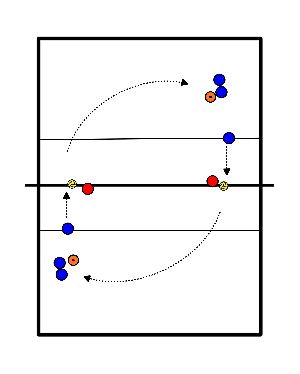
3 laps around the field, then divide over the back line.
- run with arms forward
- walk with arms backwards
- lift heels
- lift knees
- sideways left
- sideways right
- cross pass
Strength exercises together:
- situps
- squats
- planks
- T touches the ball
- Defend with a pass to T
- then short tip ball
- Three must do block defence
- Finish the attack in threes
5 times then next threesome
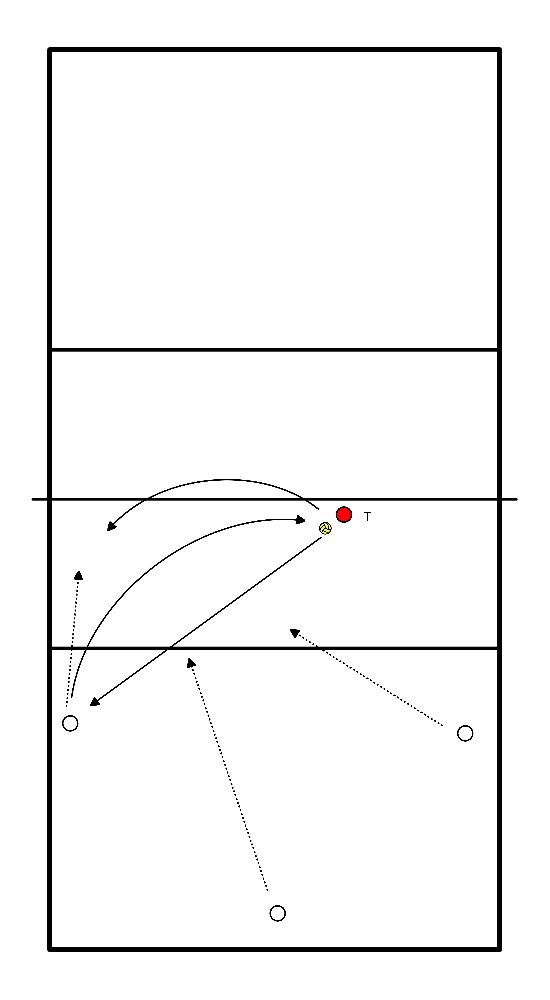
- system with on one side the line-up with the libero
- and on the other side a line-up with the youth players.
- So the youth players can also learn the system.
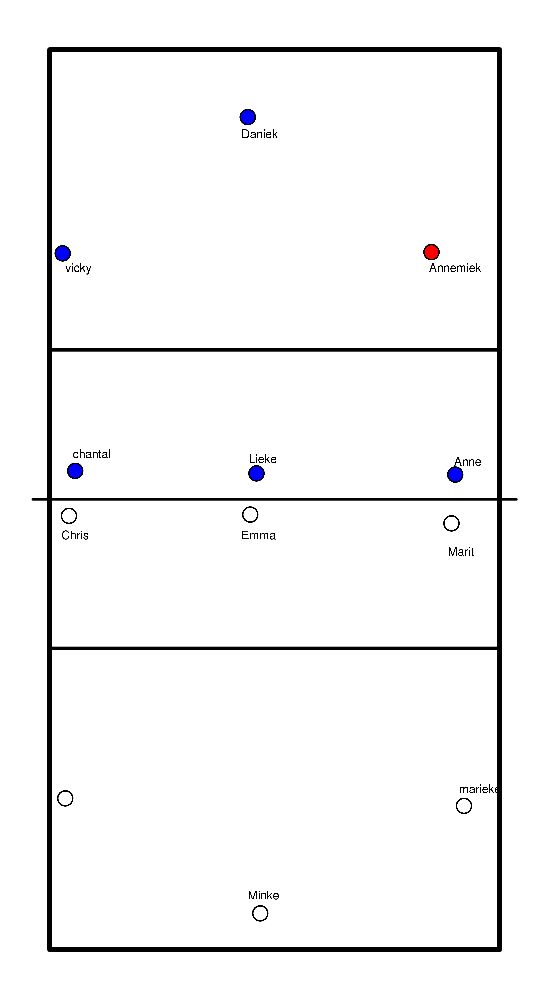
https://youtu.be/bYJZ3UkSVMM
- Per 3 players
- 2 balls. person 1&2 stand on 1 side,
- person 3 in the middle opposite them.
- Person 1 throws a ball to person 3,
- who plays it back to person 1 underhand.
- Then person 3 moves in shuffle until she is opposite person 2, this person also throws a ball which person 3 in turn plays back underhand.
- Then move sideways again to person 1
- So continuously move sideways to play balls back underhand from person 1 and 2,
- After X number of balls you change
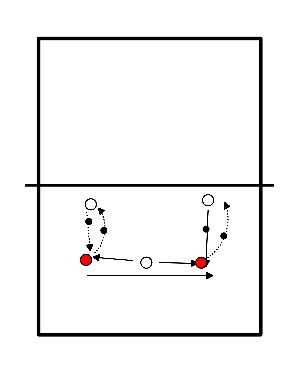
- Player 1 throws the ball to player 3, who defends it underhand to person 2.
- Person 2 throws the ball to 3, who defends it to person 1 (so defend it diagonally every time).
- First throw everything (player 1 and 2, after that everything BH, after that technical hit).
- The players all stand side by side at the net
- with their faces turned to the net
- and in the proper position to want to block,
- so elbows and hands at the right height.
- The coach throws a ball from the other side of the net to the players and they each take their turn to block their thrown ball.
- On each side a row of attackers.
- All have a ball, except the one at the net.
- At the same time throw the ball to the other side and pass the ball from the other side.
- After a while throw the ball from the middle to the right side and pass it again.
- After passing catch the ball.
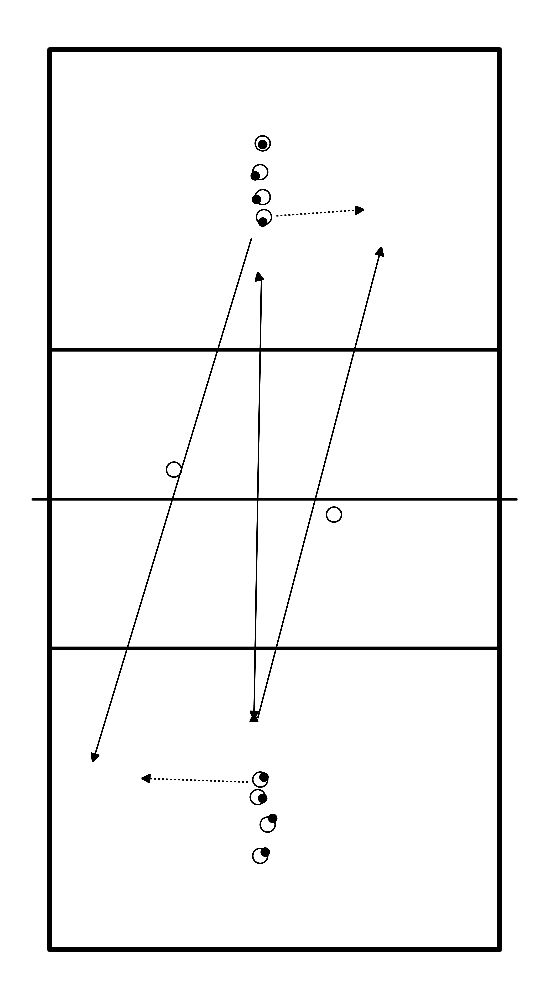
Three in a row on the back line.
Trainer throws ball. Players walk into the field.
- Passes
- gives set-up
- attack
Now the trainer calls a number, 1, 2, or 3 and he has to play first.
The player behind takes the second ball and so on.







